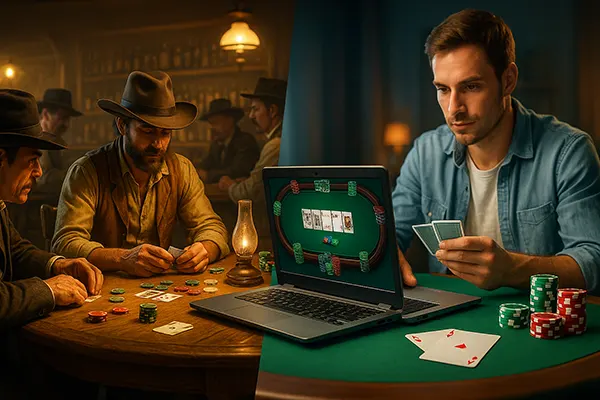
The Evolution of Poker: From Saloons to Online Tournaments
Poker, one of the most iconic card games in the world, has a rich history that spans centuries. From its humble beginnings in smoky saloons to becoming a global phenomenon with online tournaments, poker’s evolution is a fascinating journey. This article explores how poker transformed from a niche pastime into a mainstream competitive sport.
The Origins of Poker: Early Days in Saloons
The earliest form of poker can be traced back to the 19th century in the United States. Often associated with the Mississippi Riverboats and frontier saloons, poker began as a simple betting game with a deck of 20 cards. Initially, it was a rough and ready game, played by gamblers looking for a quick thrill.
As poker spread across the American West, the rules started to evolve. The introduction of the 52-card deck in the mid-1800s marked a significant change, making the game more complex and strategic. With the rise of saloons, poker became an integral part of American social life, where cowboys and traders gathered to try their luck and skill.
During this period, poker gained a reputation as a game of cunning and deception. Players would often use bluffing to intimidate their opponents, a strategy still integral to modern poker. As the game moved from saloons to more formal gambling establishments, it began to develop regional variations.
The Impact of the American Civil War
The American Civil War played a pivotal role in spreading poker across the country. Soldiers from different regions introduced their own versions, including Stud Poker and Draw Poker. This diversification contributed to poker’s growing popularity, as it became a symbol of camaraderie and rivalry among troops.
By the late 19th century, poker had firmly established itself as a staple in gambling halls across the United States. Its reputation as both a game of chance and skill attracted players from all walks of life, setting the stage for its global expansion in the 20th century.
Despite its growth, poker retained its rough, unpredictable nature. The game was still largely unregulated, leading to occasional disputes and even violence among players. However, this only added to its allure, cementing poker’s place in American folklore.
Modernization of Poker: Casinos and Tournaments
The 20th century saw poker transition from informal settings to organized, professional environments. The establishment of casinos in Nevada during the 1930s marked the beginning of poker’s legitimization. Casinos provided a regulated environment, reducing the risk of cheating and enhancing the game’s reputation.
In 1970, the World Series of Poker (WSOP) was launched in Las Vegas, revolutionizing the game. This annual event brought together top players from around the world, showcasing poker’s competitive potential. Televised tournaments in the late 20th century made poker a spectator sport, drawing millions of viewers.
The introduction of Texas Hold’em as the main event at the WSOP further increased poker’s popularity. Its simple rules yet strategic depth made it accessible to both amateurs and professionals. As a result, poker rooms flourished across the United States and Europe.
The Role of Media in Poker’s Popularity
Television coverage of poker, particularly with the advent of the “hole card camera,” transformed the game into a dramatic and engaging experience for viewers. Audiences could see players’ hands, adding an element of suspense and insight into strategies.
This media exposure not only made poker more appealing but also helped demystify the game. As viewers learned the strategies and psychology behind poker, more people felt confident enough to participate in tournaments, both live and online.
Throughout the 1990s, poker’s reputation shifted from a game of chance to a legitimate mental sport, requiring skill, patience, and strategic thinking. This new perception paved the way for poker’s digital evolution.

The Digital Revolution: Online Poker
The rise of the internet in the late 1990s brought poker into the digital age. Online platforms allowed players to compete from the comfort of their homes, eliminating geographical barriers. Sites like PokerStars and Full Tilt Poker became hubs for enthusiasts worldwide.
Online poker tournaments became immensely popular, offering large prize pools and the chance for amateurs to challenge professionals. The “Moneymaker Effect” in 2003, when Chris Moneymaker won the WSOP after qualifying through an online satellite, sparked a poker boom.
Today, online poker remains a major force in the gaming world. With technological advancements such as live dealer games and mobile apps, poker continues to evolve, attracting a new generation of players seeking both entertainment and competition.
The Future of Poker
As technology advances, poker is poised to continue its evolution. Virtual reality (VR) and blockchain technology are introducing new ways to experience the game, offering immersive environments and secure transactions.
The rise of esports has also influenced poker, with professional players streaming their sessions online, attracting large audiences. This convergence of gaming and poker highlights the game’s adaptability in a rapidly changing digital landscape.
Whether played in a casino, online, or through VR, poker remains a game that balances luck and skill, heritage and innovation. Its enduring appeal lies in its ability to adapt while maintaining the strategic essence that captivated players centuries ago.

